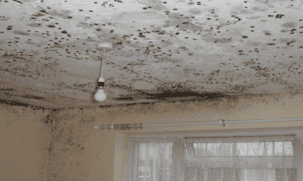Condensation – a black mark for property.

Black mould associated with condensation is becoming an increasing problem for homes in the UK and following the tragic death of Awaab Ishak, one that is high on the agenda for housing managers.
Mould is a microfungus and may be one of several species. Funguses are living organisms so need moisture to survive and thrive.
The most common cause of black mould is condensation. Air normally contains water vapour in varying quantities and its capacity to do so is related to temperature. The warmer the air the greater its capacity to hold moisture. The amount of moisture in the air is usually expressed as Relative Humidity (RH), which is a percentage of the maximum amount of water vapour the air has the capacity to hold at a given temperature.
Air is saturated when it cannot contain any more water vapour at the existing temperature; under these conditions, it is said to have reached a relative humidity of 100%. If the temperature of the air falls until saturation point, the air is at a critical temperature at which it cannot hold any more water. This temperature is known as the dew point. At this temperature, it will result in water vapour being forced to condense out as liquid water.
This is usually seen in rooms with high moisture production like bathrooms and kitchens, with condensation most likely to appear on external walls, corners and behind furniture. This is because these tend to be colder and less ventilated so more prone to air temperature change.
Whilst condensation is a normal occurrence in every home, if too much moisture is allowed to build up without sufficient ventilation this will provide the right environment for moulds, or funguses, to grow. Mould is not just an eyesore but can have serious impacts on both the health of occupants and some types can impact the building itself.
Moulds can emit harmful spores into the surrounding air, which can cause respiratory issues for people at risk. Children, the elderly and those with existing allergies or lung conditions are most at risk. As seen with the tragic case of Awaab Ishak, when left unresolved the health impacts of mould can be devastating.
But the problem does not stop there, mould can also cause damage to the building, starting with the interior like carpets, furniture, and curtains. Mould can even spread to the structure of the property and is especially harmful to timber. We have probably all heard the term ‘dry rot’. This is a type of fungus that attacks timbers in our homes.
So, what are the solutions?
It is important to remember that no two cases of mould are the same and what is the cause and solution in one case will not be the same in another.
That being said, condensation mould can be managed through three things: temperature, prevention of moisture, and ventilation. Or to put it another way, raising the room temperature and avoiding cold surface temperatures, reducing the amount of moisture that gets into the air and replacing wet air with dry air.
As a rule of good practice, Geoff Hunt, building surveyor and Sava trainer, recommends that properties should be kept at around 21 degrees in the day and 16 degrees at night, never dropping below 14 degrees. This will help to avoid condensation problems and whilst easier said than done, with current energy prices, sticking between these temperatures is one of the best preventative measures that can be taken.
Another preventative change is to simply limit the amount of moisture being produced. This can be done by having shorter showers and physically removing water afterwards with a squeegee and cooking with lids on pans where possible. It can also be addressed by finding another way to dry clothes other than on radiators etc.
However, solving condensation mould is not always easy and action may be needed to change heating, insulation, or ventilation systems or a combination of all three.
Achieving greater energy efficiency in our homes is of course a top priority and improving insulation has a large part to play in this. However, when not carried out properly insulation measures can actually fuel further condensation mould issues. The process of insulating homes often results in ventilation being restricted, this can jeopardise the moisture management potentially leading to increased condensation and therefore mould.
This conflict is more common when considering traditional properties (pre-1919). Older properties were built to be ‘vapour open’, meaning moisture was able to pass through the fabric of the building and through natural ventilation via chimneys etc. Modern houses are more likely to be ‘vapour closed’, preventing moisture from leaving the building. Complications arise when using modern, vapour-closed materials to insulate traditional properties as these change the way the building removes moisture from the air. This can result in more moisture being trapped in the property and thus more condensation, increasing the likelihood of mould.
This is not a reason to abandon insulation or to stop pursuing increased energy efficiency. But it is worth bearing in mind as we adapt our homes to fit changing agendas that we consider a ‘whole house’ approach and be aware of unintended consequences. Ultimately, homes must remain fit for their ultimate purpose – providing us with safe shelter.
There are further articles on moisture in buildings on Sava EDGE, Sava’s online library. You will need to register for a free account.
